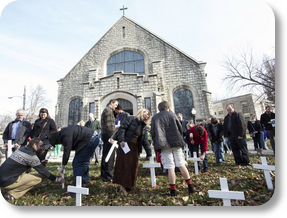
Violent crime in Louisville was up about 10 percent in 2014, breaking a downward trend the city had seen since 2012, police data shows.
There were 3,681 violent crimes in Louisville through November, according to preliminary data from the Louisville Metro Police, up from 3,342 at the same time a year before. Full crime data for December will not be available from the police until mid-January, but for all of 2013, there were 3,644 violent crimes - a mark that has already been surpassed.
Col. Ozzy Gibson, deputy chief of police, said that while a one-year uptick in crime is never good, violent crime has fallen about 5 percent in the city since 2007.
"We're coming off two low years," Gibson said. "Overall, over the last seven years, we've done a lot of good work to be able to say a city of our size with a population increase that we're down 5 percent."
Violent-crime statistics fluctuate yearly, of course. Some years the change is small, like when violent crime grew nearly 2 percent from 2007 to 2008. Other years it's bigger, such as from 2008 to 2009, when violent crime fell more than 12 percent.
The city saw an 11 percent dip in violent crime between 2011 and 2013.
But in 2014, all measures of violent crime were up, with aggravated assaults and robberies driving much of the increase.
Anthony Smith, director of the Office for Safe and Healthy Neighborhoods that is tasked with finding a long-term solution to curb violence in the city, said he does not get too caught up in the year-to-year data.
"You hope to see a downturn in the violent crime," he said. "We would love to see that number tick down, but we know we will occasionally see the things like we saw on March 22."
Smith was referring to mob violence that ended in more than a dozen teens facing assault, robbery and burglary charges and left many in the city apprehensive about public safety.
Smith's position and office grew out of the recommendations of the Violence Prevention Work Group, which was assembled by Mayor Greg Fischer in 2012 after a triple murder in Parkland shocked the city.
But Smith said public-safety efforts will take time. The office is focused on disrupting the cycle of unemployment and lack of education that, in part, leads to the violence.
He pointed to the Right Turn program, which recently received $2.25 million in federal grants to pair teens in the court system with volunteer mentors, who will help the youths with educational and career planning. But he stressed the need for more citizens to get involved in decreasing the crime numbers through mentoring.
"Have we been able to turn violence down completely? No," Smith said. "But have we been able to allocate resources that will have a lasting impact? Yes."
Three of the eight citywide patrol divisions generated more than half of the city's violent crime: the fourth, which covers Smoketown, Churchill Downs, the Fairgrounds, South Louisville and Old Louisville; the first, which covers Portland, Russell and Phoenix Hill; and the second, which covers Shawnee, Chickasaw and Park DuValle.
The ZIP codes with the most homicides, according to police data through Dec. 23, were 40203 with 10, 40211 with seven and 40210 with six - generally in those same areas.
Through mid-December, police recorded approximately 223 criminal gunshot injuries, Gibson said, adding that they were on par with previous years.
There were 52 murders in Louisville through November of this year, up from a total of 48 in all of 2013, but down from 71 in 2007 and 2008, according to police data.
There have been at least another five murders since the November data was released, including the shooting of 16-year-old Shavon Ross and the stabbing death of Porcia Mills, who police say was killed by her ex-boyfriend with her toddler nearby.
Gibson said there's no pattern to explain the rise in homicides, but he did note there has also been a rise in domestic violence killings.
Some of the high-profile murders have drawn public outcry.
In August, 16-month-old Ne'Riah Miller was fatally shot in the arms of her mother. In October, 12-year-old Ray Etheridge was stabbed to death in Cherokee Park. In November, three teens were charged with murder and robbery in connection with the death of cab driver Papa Thiam, was shot to death in his cab. On Dec. 30, a young black man was found dead inside a home in the Parkland neighborhood. On Dec. 31, a man was shot and killed in a domestic dispute in Newburg, according to police.
The morning after her great-granddaughter was killed, Sherrie Miller wiped away tears at the shooting scene.
"We're supposed to be brothers and sisters. We're supposed to love one another," she said. "Why do we have to kill?"
Gibson said the police plan to focus in 2015 on engaging with the community before crime occurs to help residents understand why police are more active in their neighborhood than others.
Rather than the old method of "chasing dots," or simply responding to crime as it happens, Gibson said the department is increasingly using historical data to map crime hotspots, which in turn can influence their patrols.
"At least they need to know why we're there, what we're seeing," he said.
Police and community relations are a focus for Ray Barker of ManUp, a group focused on empowering men of the community to stand up against the violence around them.
"When it comes to dealing with violent crimes in west Louisville, most law-abiding citizens know the police have a very tough time out there making sure things stay safe in our community," Barker said. "But at the same time, citizens want to make sure the system is applying the law justly and fairly."







